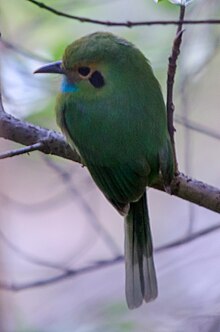| Blue-throated motmot | |
|---|---|

| |
| Conservation status | |
 Least Concern (IUCN 3.1) | |
| Scientific classification | |
| Domain: | Eukaryota |
| Kingdom: | Animalia |
| Phylum: | Chordata |
| Class: | Aves |
| Order: | Coraciiformes |
| Family: | Momotidae |
| Genus: | Aspatha Sharpe, 1892 |
| Species: | A. gularis |
| Binomial name | |
| Aspatha gularis (Lafresnaye, 1840) | |

| |
The blue-throated motmot (Aspatha gularis) is a species of bird in the family Momotidae. It is found in El Salvador, Guatemala, Honduras, and Mexico.
Taxonomy and systematics
The blue-throated motmot is monotypic. It apparently has no close relatives.
Description
The blue-throated motmot is 25.5 to 28.0 cm (10.0 to 11.0 in) long and weighs 56.0 to 67.3 g (1.98 to 2.37 oz). It has a long, graduated, tail that in contrast to that of most other motmots does not have racquet tips. The side of the adult's head is ochre with a black "ear" spot. It is mostly green above and paler green below. The throat is blue with a black spot just below it. The juvenile is duller and the green of the back is washed with olive.
Distribution and habitat
The blue-throated motmot is found from Oaxaca and Chiapas in Mexico south and east through Guatemala and a bit of El Salvador to Honduras. It inhabits montane evergreen and pine forest of medium to high humidity. In elevation it ranges from 1,300 to 3,000 m (4,300 to 9,800 ft) in Mexico but in Honduras it is not found below 1,800 m (5,900 ft).
Behavior
Feeding
The blue-throated motmot forages by plucking insects, especially beetles, from foliage while flying. It also eats some fruit and apparently feeds fruit to nestlings.
Breeding
The blue-throated motmot nests in a burrow that it excavates in an earth bank; the burrows can be up to 1.8 m (5.9 ft) long and often have bends in them. In Guatemala it lays eggs in April, and a fledgling was collected in late May in Mexico. The clutch size is three.
Vocalization
The blue-throated motmot typically calls from a high exposed perch. It usually gives single "hoot" or "huuk" notes but sometimes strings them together as "hoodloodloodloodl..." .
Status
The IUCN has assessed the blue-throated motmot as being of Least Concern. Though its population appears to be decreasing, its population and range are large enough to achieve that rating
References
- ^ BirdLife International (2020). "Aspatha gularis". IUCN Red List of Threatened Species. 2020: e.T22682983A152200542. doi:10.2305/IUCN.UK.2020-3.RLTS.T22682983A152200542.en. Retrieved 7 October 2023.
- Gill, F.; Donsker, D.; Rasmussen, P. (January 2021). "IOC World Bird List (v 11.1)". Retrieved January 14, 2021.
- ^ Snow, D. and G. M. Kirwan (2020). Blue-throated Motmot (Aspatha gularis), version 1.0. In Birds of the World (J. del Hoyo, A. Elliott, J. Sargatal, D. A. Christie, and E. de Juana, Editors). Cornell Lab of Ornithology, Ithaca, NY, USA. https://doi.org/10.2173/bow.bltmot1.01 retrieved May 4, 2021
External links
| Taxon identifiers | |
|---|---|
| Aspatha gularis |
|







